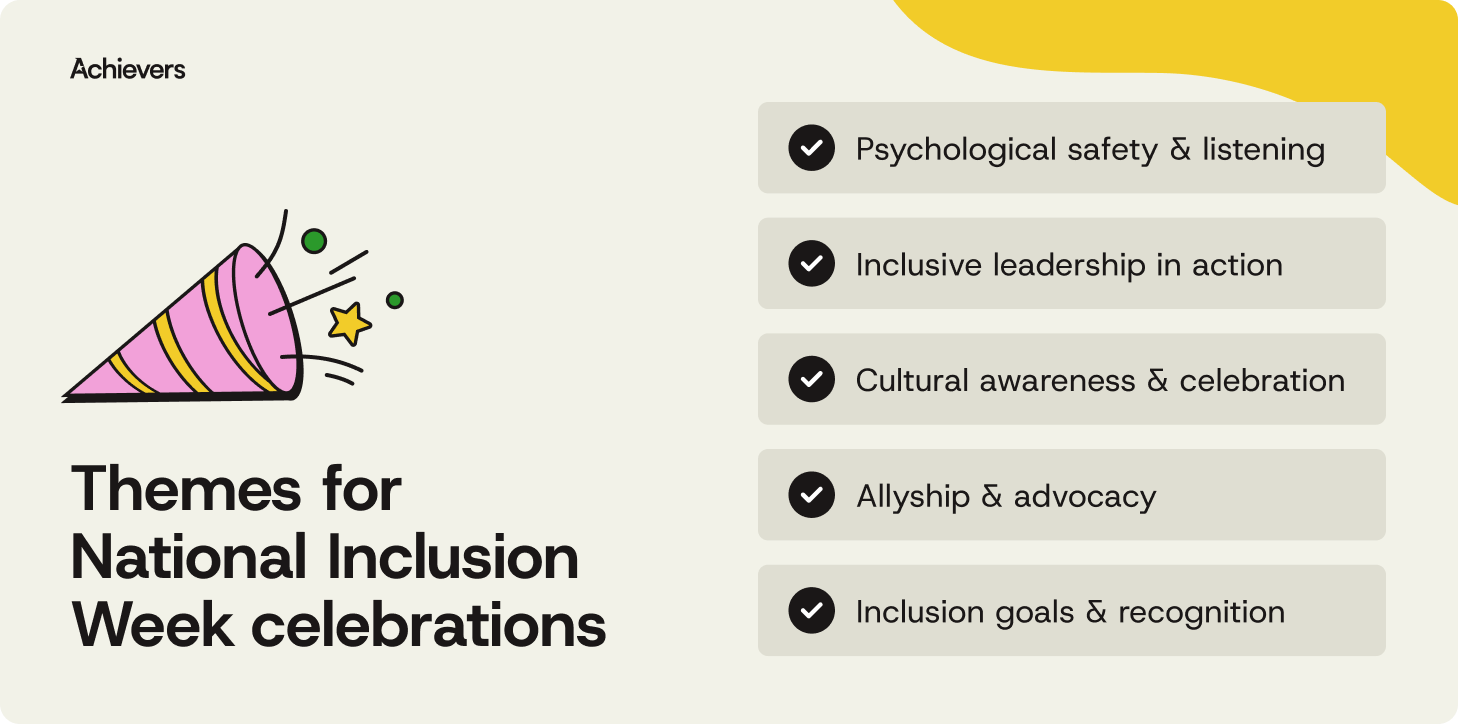Table of contents
Create a culture that means business™
Schedule a demo with an Achievers solution expert today.
Looking for meaningful ways to spotlight diversity, equity, and inclusion (DEI) in your workplace? National Inclusion Week — taking place September 15–21, 2025 — is the perfect opportunity. This annual event goes beyond words on a values page. It’s a call to action to make inclusion a daily practice that fuels belonging, engagement, and innovation.
Dedicating a week to connection and learning isn’t just good for employees — it strengthens your entire organization. In this blog, we’ll explore what National Inclusion Week is all about, why it matters, and share a five-day agenda to help your team celebrate with intention.
What National Inclusion Week is (and why it matters)
National Inclusion Week was launched by Inclusive Employers, a leading organization dedicated to embedding diversity into workplace culture. Held annually, this week encourages meaningful conversations around intersectionality — across race, gender, religion, sexual orientation, and more. Each year introduces a new theme to guide action, and 2025’s theme, “Now is the Time,” highlights the urgency of building sustainable, everyday inclusion into workplace practices.
At its heart, inclusion is a reminder that everyone matters — and that they belong. Recognizing this during National Inclusion Week sparks a ripple effect: it boosts employee well-being, strengthens engagement, improves retention, and drives better performance. The benefits extend to the bottom line, too. According to McKinsey & Company, companies in the top quartile for board-level diversity are 27% more likely to outperform their peers financially.
Your 5-day agenda for National Inclusion Week
Bringing inclusion to life during National Inclusion Week is easier—and more impactful—when you follow a clear, intentional plan. Start each day with a dedicated theme that encourages reflection, conversation, and action around workplace inclusion.
Use the following five-day agenda as a springboard to spark dialogue, build empathy, and strengthen allyship across your organization:

Day 1: Psychological safety & listening
Gathering feedback, allowing for questions, and inviting conversations are key to improvement and inspiring positive change. Creating a “psychologically safe” environment means individuals can contribute by speaking about ideas, concerns, questions, or mistakes without suffering negative social or professional consequences.
To encourage psychological safety in the workplace, try the following:
- Listening circles or safe-space sessions: Create spaces where employees can share their experiences without judgment.
- Pulse surveys: Gather anonymous feedback about inclusion and belonging.
- Share short videos: Share TED Talks or short clips that explore psychological safety and inclusive leadership.
Day 2: Inclusive leadership in action
Sometimes, the best way to set a powerful example is to bring in the experts. Foster open conversation and ensure it’s done right by engaging leaders who actively champion inclusion. Their presence can inspire trust, set the tone for employee wellness, and spark lasting change for a truly healthy work environment.
Ways to promote inclusive leadership include:
- Host a panel: Invite inclusive leaders to share experiences and insights.
- Offer mini-training: Focus on topics such as inclusive language or bias-aware decision-making.
- Share real stories: Highlight examples of mindful leadership in everyday moments.
Day 3: Cultural awareness & celebration
What better way to celebrate diversity than starting with your people? Employees bring a wide range of cultures, experiences, and perspectives to the workplace. When you create space for cultural sharing, you foster a sense of belonging, inclusion, and mutual respect. It also gives teams a chance to connect more meaningfully and learn from one another in authentic ways.
Try the following to celebrate cultural awareness:
- Encourage cultural sharing: Invite employees to share traditions, holidays, or personal stories.
- Create a culture wall: Use a virtual or physical space to display photos, quotes, recipes, or flags.
- Feature spotlight profiles: Highlight team members from underrepresented or historically excluded groups.
Day 4: Allyship & advocacy
Model the right behaviors by showing allyship and advocacy in the workplace. When leaders and peers actively demonstrate inclusivity, it sends a clear message: everyone belongs. It also provides employees with the opportunity to learn by example and understand how to put inclusion into practice.
Promote allyship and advocacy through these ideas:
- Launch an allyship challenge: Encourage small daily actions, like active listening or speaking up against bias.
- Share practical tools: Offer guidance on how to support colleagues and speak out against exclusion.
- Host a roundtable: Facilitate conversations about advocacy across different identities and lived experiences.
Day 5: Inclusion goals & recognition
On the final day of National Inclusion Week, take time to reflect, celebrate, and plan for the future of work. This is a valuable opportunity to recognize what was learned, capture feedback, and align on future inclusion goals. Reflection reinforces learning, while recognition and next steps help sustain momentum beyond the week.
Use the final day to bring everything together:
- Reflect on key learnings: Invite teams to share takeaways and personal commitments.
- Recognize impact: Celebrate individuals or teams who demonstrate inclusive behaviors.
- Encourage a future focus: Invite leaders to share how they’ll continue championing inclusion.
Launch tips: Planning & promotion
Before launching National Inclusion Week, thoughtful planning and effective promotion can make all the difference. Here are some key tips to ensure your event runs smoothly and inclusively:
- Lead from the top: Senior leaders should actively participate; this includes modeling vulnerability, sharing personal stories, and advocating for inclusion. Leadership buy-in inspires wider engagement across the organization.
- Use multiple channels: Use internal communication channels like email, team calendars, Slack, newsletters, or intranet banners to create anticipation and keep momentum going throughout the week.
- Encourage participation: Make the week fun and rewarding. Offer light incentives such as points-based rewards, shout-outs, or small prizes to motivate involvement.
- Accessible experiences: Design events to be inclusive across time zones, languages, and abilities. This might include captioned videos, multilingual resources, or flexible participation options.
By taking the time to plan with intention and promote with care, you’ll set the stage for a meaningful and impactful National Inclusion Week experience.
How to sustain inclusion beyond this week
Inclusion isn’t just a weeklong event — it’s a year-round commitment. To create lasting impact and meaningful change, embed inclusion into everyday practices through onboarding, performance reviews, and employee recognition. This helps signal that inclusion is part of a company’s core values, and not just a campaign.
Some ways to sustain inclusion for the long haul include the following:
- Keep momentum going by introducing monthly themes, such as Gender Equity Month or Accessibility Awareness Week. These initiatives provide ongoing opportunities to educate, engage, and celebrate diversity throughout the year.
- Transparency is key. Share metrics and stories regularly to highlight both progress and areas for growth. This builds trust and keeps inclusion efforts grounded in accountability.
- Finally, create space for open dialogue. Encourage feedback through both anonymous pulse surveys and live conversations to ensure all voices are acknowledged.
Sustaining inclusion takes intention and consistency, but when done well, it fosters a company culture where everyone can thrive, contribute, and feel they truly belong.
Keep the momentum going
Inclusion Week isn’t the finish line — it’s a catalyst. Use this five-day framework as a starting point, then adapt it to reflect your team’s unique values, voices, and goals.
Recognition, honest conversations, and clear commitments should continue long after the week ends. That’s how inclusion becomes part of your everyday culture — not a campaign, but a habit.
With support from tools like Achievers, you can reinforce inclusive behaviors, elevate employee voices, and turn feedback into meaningful action. Because when everyone feels seen, heard, and valued, inclusion isn’t just a goal — it’s how your workplace thrives.



